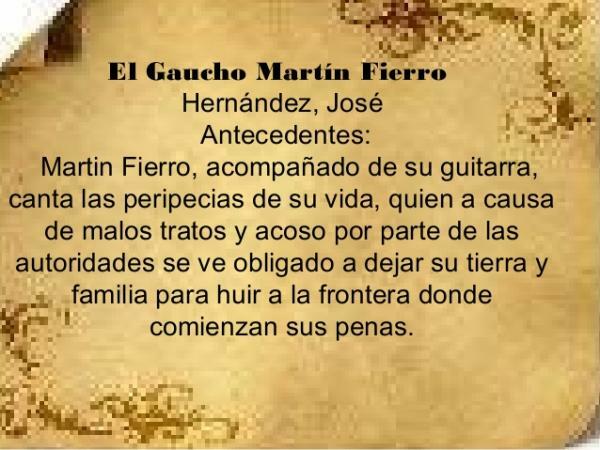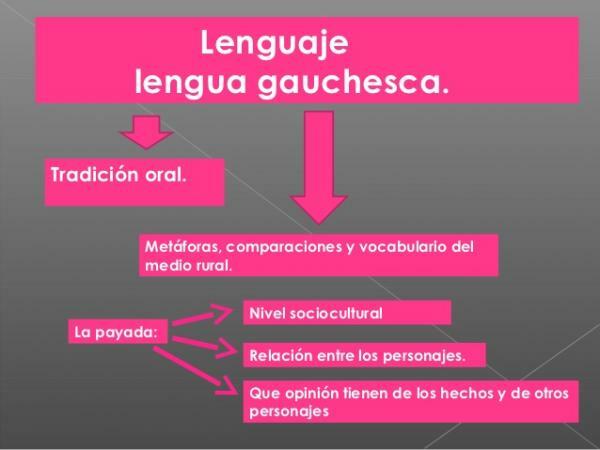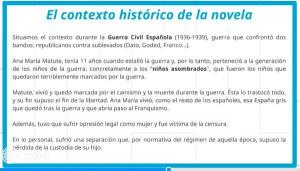Complete literary ANALYSIS of Martín FIERRO: context, plot, character, style ...

One of the most outstanding works of Argentine and universal literature is Martin Fierro, a text that is part of gaucho literature and that narrates the lifestyle of the gauchos, inhabitants of the Argentine Pampas who became the ideal heroes for the romantics. In this lesson from a TEACHER we want to show you a complete analysis of Martín Fierro so that you better understand its plot, the characterization of the character, the style of the poem and the language used throughout the play. A literary analysis that will allow you to better understand the greatness of this poem that has become a classic of universal letters.
Index
- Introduction to Martín Fierro and gaucho literature
- Brief summary of Martín Fierro's argument
- Language in Martín Fierro
- The character of Martín Fierro
Introduction to Martín Fierro and gaucho literature.
We begin this analysis of Martín Fierro by making a brief presentation of this text that was written by Jose Hernandez
and published in 1872. It is a narrative poem that is written entirely in verse and is considered the masterpiece of gaucho literature. Is composed of two parts: The round trip (published this second part in 1879).This poem stars Martín Fierro, a gaucho who is completely affected by social injustice and will end becoming a "matrero gaucho", that is to say, a man who will live outside society and the laws. This character has become a prototype of what the Argentine gauchos were like: lonely, brave, hard-working and independent people who lived in the Pampa area.
During the text we actually attended a social criticism which refers to the policy undertaken by Domingo Faustino Sarmiento, the president of Argentina who recruited the gauchos by force to defend the borders and prevent the attack or invasion of the "Indians" or indigenous people.
Today, Martín Fierro has become one of the most representative books of Argentine culture and has been translated into more than 70 languages.
What is gaucho literature
In this analysis by Martín Fierro, it is important to make a aside to talk briefly about the gender of the gaucho literature. It is a genre that appeared only in Argentina and that focused on recounting the life that the country's gauchos led, their day-to-day life, their customs, their traditions, and so on. Normally, they are texts in which there is an important protagonism of the landscape since the Pampa area is a completely natural area and it was where the gauchos lived.
Another characteristic point of this type of literature is that they appear typical characters of society of the moment as were the Creoles, the blacks, the mestizos, the gringos, the Indians... A very plural society full of miscegenation that is reflected throughout these literary texts.
We must not forget that gaucho literature appeared at a time when the Romanticism movement was still present in art and, therefore, the figure of the gaucho is usually presented in an idealized way since represents the romantic ideal: a man who lives simply, surrounded by nature and who is a singer. In addition, the gaucho also represents an important part of the country's tradition and folklore, something that the romantic movement also pursued when it wanted to find the identity of each nation.

Brief summary of Martín Fierro's argument.
In order to continue with Martín Fierro's analysis, it is important to understand what the work is about and, therefore, here we leave you with a brief summary of Martín Fierro which will introduce you to the plot that is explained throughout the poem. In the first part, La ida, we find the presentation of Fierro, a hardworking man who lives with his family in La Pampa. Yet one day he is forced to be part of the military strategy imposed by the State where the gauchos had to defend the borders of the indigenous people.
From this moment on, Martín's life will live a clear upheaval and he will find himself alone living in a hostile territory and where, in addition, there are excessive abuses of power by the authorities. During the poem we are told about the misadventures that Fierra stars, who suffers from hunger, cold and constant punishment. After three years suffering this abuse, Martín decides to escape and this is how he becomes a deserter, a person who will live on the fringes of the law and society.
He returns to his ranch and finds that is completely abandoned: his wife has died and his sons have left. With no place to return to and no family to love, Martín starts going to the "pulperías" (taverns) where he drinks and ends up becoming a gaucho matrero. At this moment will be when he will commit two murders and this will make him be persecuted by justice; In this pursuit he will meet Sergeant Cruz, a man who will end up joining the flight of Martín Fierro and, together, they will go to the desert to try living with the Indians.
The return of Martín Fierro, the second part of the work
In The Return of Martín Fierro we find the continuation of the adventures of this tragic character. Life with the Indians has not turned out well and, therefore, the gaucho decides to return and try to reconnect with his children. In this other book will appear a new character, Picardy, which will also narrate the story of his life in a very special song.
It will also be in this book when we learn about the history of the children, what they have experienced after the death of their mother. Sergeant Cruz will die during the trip and Martín Fierro he will end up reuniting with the children and the poem will end with a series of advice that the father gives to his children.

Image: Slideshare
Language in Martín Fierro.
One of the most outstanding points of this gaucho poem is the use of language and, therefore, we could not fail to mention it in this analysis by Martín Fierro. And it is that José Hernández really wanted to reflect what the Argentine gaucho was like and, therefore, he had to cultivate exact language that was spoken among the people of this community.
During the poem we find expressions and words typical of the rural communities of Argentina and, with this, what the author achieves is to dignify rural speech by placing it in a poetic and literary text. For this reason, throughout the text we can find a type of informal speech that presents features like the ones that we will discover here:
- Vowel reduction: in rural speech it is common to bet on a simpler pronunciation and, therefore, forms such as "pacencia" appear instead of "patience"
- Reduction of consonant clusters: It is also common for some consonant forms to be reduced to facilitate pronunciation or speak faster. It is the case of using the word "victim" instead of "victim"
- Loss of the intervocalic "d": at the end of the word, in endings with "/ -ado" it is common that in rural areas this "d" is weakened and eventually elided.
- The "d" becomes "l": this phonetic characteristic also occurs in Spain, especially in the Canaries. It is when the use of "d" is changed by "l" in words like "amol" instead of "love". A feature that is also very typical of Cuban speech.
- Aspiration of the "h": there is usually an important phonetic change in which the "h" becomes aspirated creating a sound similar to that of the Spanish "j".
Martín Fierro's metric
We have already commented that Martín Fierro's work is a poem in verse and, therefore, it is important to pay attention to the metrics that we find in the text. Here we leave you the metric characteristics highlights of Martín Fierro:
- Octosyllable verses
- The stanza that predominates is the sextet
- The scheme that is followed throughout the poem is abbccb
- It has rhyme
It is important to note that not all the stanzas follow this metric since we also find romance or redondillas.

Image: Slideshare
The character of Martín Fierro.
To conclude with this analysis by Martín Fierro, it is important that we stop at the characteristics of the protagonist of the poem. As we have already said, Fierro stands as a prototype of the Argentine gaucho, a lonely, hard-working and independent character who lives in the Argentine region of La Pampa. The author created a idealized image of the gaucho giving him the attributes that the romantics so revered in the poets: rebellious spirit, solitary, in constant contact with nature, passionate, and so on.
There are many theories as to whether the Martín Fierro's character actually existed. There are some critics who have indicated that Hernández was a friend of Zoilo Miguenz, the founder of a political party. known as Ayaucho and where the name of Meliton Fierro appears, who is believed to be the alter ego of Martin.
In La ida we witness the total destruction of Martín that he begins by presenting himself as a father of a family and a hard-working man and, because of society, ends up living in isolation with the Indians. This change is caused by the action of politicians who force him to leave to defend the borders and give him a totally unfair treatment and with a constant abuse of authority. This deeply marks Martín who decides to leave there and recover his family: but she has also been affected by his departure. The protagonist will end up completely breaking with civilization by murdering a black gaucho. Therefore, Fierro excludes himself from that pre-modern society that he had in Argentina to go live with the indigenous people.
In The Return, however, we see that Martín revalues Argentine society since the country began to take a turn towards a modernization with capitalist overtones. In this second part, the protagonist abandons his rebellion to try to recover his family and help his children have a better future.
If you want to read more articles similar to Martín Fierro: literary analysis, we recommend that you enter our category of Reading.
Bibliography
- Hernández, J. (1967). El Gaucho Martin Fierro / the Gaucho Martin Fierro. SUNY Press.
- Sarlo, B. (1982). Vanguard and criollismo: The adventure of "Martin Fierro". Journal of Latin American Literary Criticism, 8 (15), 39-69.
- Hernández, J., & Bunge, C. OR. (1913). Martín Fierro: The return of Martín Fierro. LJ Rosso.
- Prieto, M. (2011). Brief history of Argentine literature. Taurus.

![Romance of the black penalty of LORCA: analysis and meaning [RESUMEN!]](/f/92266c446212661af2d7290be52d30ba.jpg?width=300&height=200)

![Fireflies by Ana María MATUTE: main and secondary characters [summary!]](/f/3bafca6c4373d19287dc9b9b2cf56503.jpg?width=300&height=200)